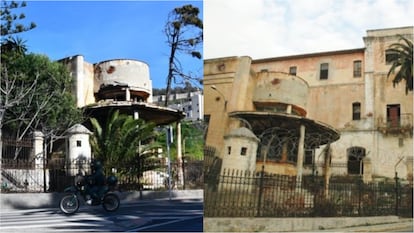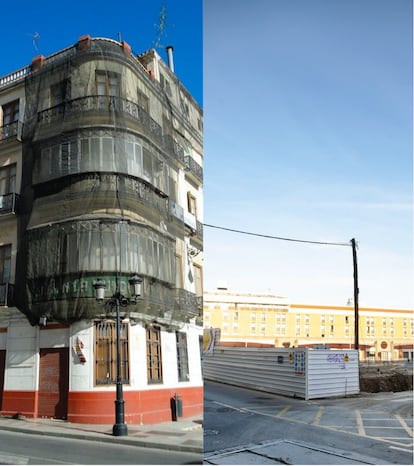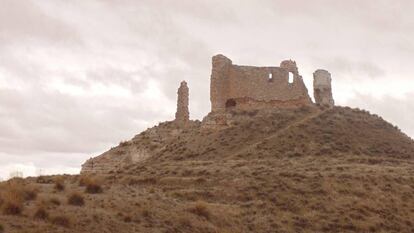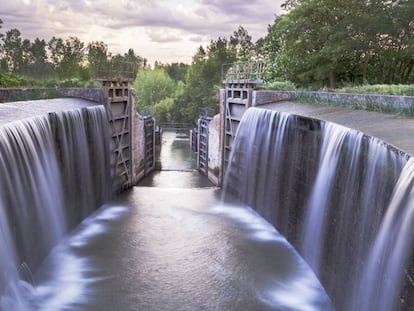The shortlist of architectural disasters in Spain
A cultural association named Hispania Nostra decries that valuable historical buildings have been defaced, badly restored, or demolished altogether


Ledigos de la Cueza, in the Spanish province of Palencia, is a tiny municipality of fewer than 70 residents. It is located around six kilometers from the even tinier Calzadilla, with a population of 40.
In the 12th century, the powerful religious and military Order of Santiago (also known as Saint James of the Sword), selected a spot halfway between both locations and built a hospital for pilgrims on their way to Santiago de Compostela. This building, which eventually became a monastery, was used chiefly by French wayfarers and noblemen, and was once known as the Abbey of the Great Knight.
Not one single stone remains of all that. The last surviving walls were torn down in 2006. This and seven other historical constructions and landscapes are included on a Black List published by an association named Hispania Nostra, which works to preserve Spain’s cultural heritage.
This group has compiled a list of monuments that have been destroyed or irreversibly modified in recent years. Hispania Nostra also has a Red List of over 900 cultural assets at risk of imminent destruction or significant alteration. Many of these sites enjoy BIC (Bien de Interés Cultural or asset of cultural interest) designation, which theoretically affords them legal protection.
Ledigos monastery

In 2006, the owners of the monastery-hospital near Ledigos tore down the building, which was in a derelict state by then. The construction had first been mentioned on August 4, 1182 when King Alfonso VII awarded it a tax exemption. The site was still open in the 19th century, run by the Order of Santiago, but when the Spanish state confiscated many of the Catholic Church’s assets in 1835, the building ended up in private hands and was turned into a farm.
“Yes, they tore everything down,” explains Jesús Evilio Dujo, the deputy mayor of Ledigos. “Nobody could go in because it was a private property. They tore it down because it was in very bad condition and there could have been an accident. It even had a church. Now there’s just an empty plot of land.” Despite its history, the monastery lacked any landmark site protection.
Ávila convention center

Hispania Nostra’s list does not just reflect demolished buildings, but also those that are considered a blot on the landscape. The association’s biggest culprit on this front is the convention center built in 2009 near the medieval city of Ávila, which is a UNESCO World Heritage Site.
The 20,000 square meter construction is described as “a brutal blunder” that “forever distorts the beautiful and world-famous view of the [medieval city] walls.” The impact is “atrocious,” says the association on its website. “It destroys the historical views that had been preserved for centuries.”
Ávila city officials disagree with this opinion. “You cannot fossilize a city. The center is far away from the north face [of the wall],” says one source. “It was built out of stone so it would blend in with its surroundings, it has won many awards, and it even won an international competition organized by the New York Museum of Modern Art.”
“Hispania Nostra took a photograph that completely distorts reality,” adds this city official. “It was taken from a very unnatural angle. The truth is, the general view of the walls has not changed or been disturbed, because the municipal convention center is built inside a depression. The cityscape remains the same it has been for centuries, whether you look at it from Los Cuatro Postes or from the road to Valladolid.”
Jerez shrine
Something similar happened to the Shrine of Guía, in the southern city of Jerez de la Frontera. Built in 1675 on top of a hermit’s abode, the shrine is still there, but in 2014, several 10-floor residential buildings were erected all around it. A local cultural association, Ateneo de Jerez, led a bid to halt the massive development project, but it was to no avail. Ateneo President José Manuel Simancas recalls that the developer went bankrupt before completing the project, and one building remains unfinished to this day.
“What was the point of this monstrosity?” he wonders. “It was for nothing. To destroy a traditional Jerez landscape that even 14th-century painters captured in their work because of its beauty.” Simancas notes that only three out of the apartments were actually sold, and the site is looking increasingly abandoned.
Carasa stone house

And then there is the restoration work that annihilates “the essential values” of some monuments, even if these are not demolished. Such is the case, says Hispania Nostra, of the house of Pico de Velasco, also known as Casa de los Godos, located in Carasa (Cantabria). The 17th-century two-story stone building once had a roof with slopes on all four sides.
In 2014, due to its poor state of conservation, its owners turned it into “something completely unrecognizable,” says the association, noting that the restorers “seem to have forgotten the history and idiosyncrasy of the building.” The restoration work “is completely unbalanced with regard to the old building, which falls into the background, and it irreversibly alters its essential values.”
The mayor of Carasa, José Luis Trueba, points out that the reforms were carried out “years ago” after getting approved by the regional real estate development committee of Cantabria. “The building was in very bad shape, that’s the truth, with no roof, and the walls in a very bad state. The owners requested permission to make reforms, and when we had all the favorable technical reports, we granted them a building license. There’s not much more to say.”
Ceuta barracks

In 2008, demolition work began on the barracks of Las Heras, in the Spanish exclave city of Ceuta, on the northern coast of Africa. Built between 1751 and 1771, this is where exiles were sent. It was one of the oldest buildings in the city and “the only testimony of the days of the presidios [fortified buildings in territories controlled by Spain].”
Urban planning officials recall how a city committee approved the demolition after much debate. Only one element would be preserved, the Rationalist pavilion. The ultimate goal was to build new barracks for the Civil Guard, but this project was never undertaken.
Úbeda prison
In the Andalusian city of Úbeda, authorities demolished the old prison in 2014, despite political and citizen protests. Only its façade was left intact. Built in 1927, it was made in the Neomudéjar style, combining brick and stone.
A city official said that at the time of demolition, the building technically belonged to Spain’s penitentiary authority, which answers to the Interior Ministry, and that it was the latter that decided to tear it down. A government representative in the province said the building’s ownership has been transferred to the Finance Ministry. “It’s not ours anymore. We don’t know anything else about it, but we’ve heard that there are no immediate plans. Maybe if you ask at the Finance Ministry....”
La Mancha house
In Manzanares (Ciudad Real), on a street named Empedrada, there was once a building over two centuries old made in the popular style of architecture used in the La Mancha area, and flanked by “the greatest concentration of protected buildings in town.” A local association named Restaura Manzanares fought to stop its demolition in 2008, but it was useless. The local chief of urban planning and heritage, Isabel Díaz-Benito, says that Manzanares is “one of the few cities to have, since 2016, a Catalog of Protected Spaces and Assets that reflects every element to be protected and preserved.”
This official admits that tearing down the Casa de la Carnicería “was clearly a mistake that should have been prevented, but that doesn’t make Manzanares a town that does not protect its heritage.”
Málaga palace

On March 31, 2019, demolition work began on the palace of the Counts of Benahavís, in Málaga, in spite of a court order putting a freeze on it, not to mention political and citizen protests. The building was erected in 1894 on the orders of Isabel Loring, Countess of Benahavís. Later the building housed government agencies and served as the governor’s residence. In the late 20th century, it became a bed and breakfast.
The wedge-shaped building, with its traditional glass-panel galleries and wrought-iron window grills, enjoyed legal protection from the city of Málaga, but the designation was withdrawn so that the building could be demolished to make way for an eight-story hotel. “It was lost in order to complete a speculative real estate operation in the area,” concludes Hispania Nostra.
The city of Málaga says that the demolition was approved by a regional council and the prosecution department in charge of historical heritage issues.
The Red List

Before joining the Black List of irreparably damaged sites, there is a Red List of endangered locations. The newest addition to the Red List is the Castle of Monreal, located on an elevated point around nine kilometers from Dosbarrios (Toledo).
There is very little left of “what must have been an imposing fortress, with a thick wall, a moat and a great central square,” according to Hispania Nostra. The building dates back to around 1200, under the reign of Alfonso VIII. The only relatively well-preserved area is the northeast corner.
Although it has BIC designation, “the progressive deterioration of the walled area and the inner vaulted rooms could lead to their definitive disappearance.”
English version by Susana Urra.
Tu suscripción se está usando en otro dispositivo
¿Quieres añadir otro usuario a tu suscripción?
Si continúas leyendo en este dispositivo, no se podrá leer en el otro.
FlechaTu suscripción se está usando en otro dispositivo y solo puedes acceder a EL PAÍS desde un dispositivo a la vez.
Si quieres compartir tu cuenta, cambia tu suscripción a la modalidad Premium, así podrás añadir otro usuario. Cada uno accederá con su propia cuenta de email, lo que os permitirá personalizar vuestra experiencia en EL PAÍS.
¿Tienes una suscripción de empresa? Accede aquí para contratar más cuentas.
En el caso de no saber quién está usando tu cuenta, te recomendamos cambiar tu contraseña aquí.
Si decides continuar compartiendo tu cuenta, este mensaje se mostrará en tu dispositivo y en el de la otra persona que está usando tu cuenta de forma indefinida, afectando a tu experiencia de lectura. Puedes consultar aquí los términos y condiciones de la suscripción digital.
More information
Últimas noticias
Most viewed
- Reinhard Genzel, Nobel laureate in physics: ‘One-minute videos will never give you the truth’
- Pablo Escobar’s hippos: A serious environmental problem, 40 years on
- Charles Dubouloz, mountaineering star, retires at 36 with a farewell tour inspired by Walter Bonatti
- Why we lost the habit of sleeping in two segments and how that changed our sense of time
- The fall of a prolific science journal exposes the billion-dollar profits of scientific publishing










































